As part of my Herbarium project, I have been working with neglected or underestimated plants. The aim is the rehabilitation of weeds, recognising the value of these plants and aiming to help people re-evaluate what they may have dismissed. Nettles seemed like an obvious choice.
I was in Bruges last year partly to see an original copy of Rembert Dodoens Cruijtboeck-his herbal book on exhibition in the apothecary of the St. Jan’s hospital. At the same period I visited an exhibition in the Gruuthusemuseum, to unexpectedly discover a book from 1369 from their collection. That connection with the past was an extraordinary experience. It was a leather-bound ledger, shaped by years of page-turning and writing and the handwritten connection made the piece even more intimate.
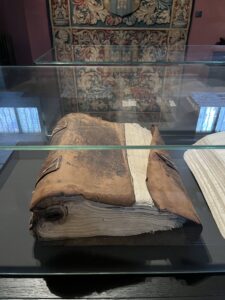
Collection of the Gruuthusemuseum, Bruges
Earlier this year I was invited to view the wonderful 17th century herbaria collection at the Royal Library of Belgium. It was an astounding day, seeing books that so many centuries of others had seen too. To see additional texts in the margins and over whole pages written by later hands, the entirety was inspiring. I loved what was actually seen as “damage”. The weight of one sample on the page below would imprint onto the page, thus particularly in books with thin paper I would have at least one ghost image.
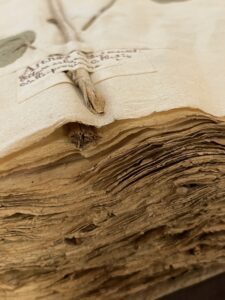
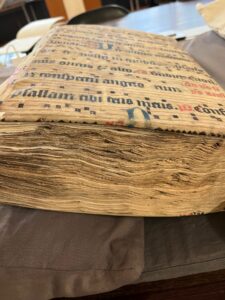
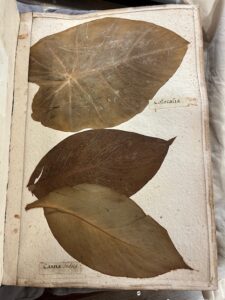
Collection and copyright Royal Library of Belgium
Some months before I had started work on the covers. These are ceramic, I wanted the complete contrast between texture and material while creating something highly tactile and three dimensional within the concept of book form. I owe thanks to the ceramic artist who helped me and who glazed the forms I had made (I’m allergic to the glazes).

Cover of the Book of Nettles, a 4th century Coptic binding style was used.
The contents were based on nettles from my garden and from the Stichting Behoud het Abbestee (a farmhouse) in Schipluiden. I was very touched that they answered my pleas for nettles earlier this year. It was a joy to return to printing in the Grafische Werkplaats in the Hague. They allowed me to use their etching presses to print relief prints from my garden plants. In short this is a project that would not have been realised without the generosity of many people, I thank you all. My thanks to the staff of the Royal Library of Belgium in Brussels in particular, for their kindness and allowing me access to their extraordinary collections. Thanks also to Rink Schelling ceramic artist, for helping and for allowing me to play with clay in her studio and realise what I had in my mind but needed to articulate into clay. My thanks also to Hans Pieterse bookbinder, who successfully takes on the challenges I give him with gusto and curiosity.
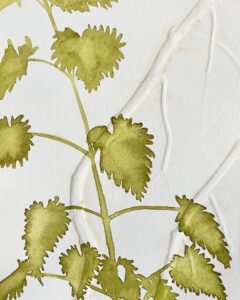


Selected “Pages” printed image and watercolour
Here is a brief YouTube short video of the book, I wanted to show the three dimensional quality of it. https://www.youtube.com/shorts/awF8n9zmwAc